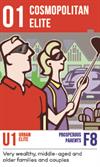The Evolving Canadian Population
Environics Analytics’ PRIZM5 Segmentation System Captures Changing Consumer Landscape
Women aged 18 to 34.
Households with incomes under $100,000.
Men aged 35 to 50 who earn over $200,000.
When it comes to marketing, most campaign managers still view consumers through the lens of age, sex and income.
But the consumer landscape has undergone massive upheaval of late, with online and mobile shopping and social media sites competing with traditional outlets to capture the attention of today’s consumers. As a result, marketers are under increasing pressure to better target customers and prospects, and many are turning to geodemographic segmentation to make sense of what consumers are thinking, buying and doing.
Based on the demographics and lifestyles of small neighbourhoods, geodemographic segmentation helps marketers develop informed strategies for prospecting new customers, re-aligning sales territories, cross-selling existing customers and predicting future opportunities. And in today’s fragmented marketplace, segmentation is especially valuable in identifying increasingly narrow target audiences and speaking to their interests—be it sustainably sourced products, civic duty or international travel.
This spring, the Canada population came into sharper focus when Environics Analytics (EA) released its latest edition of PRIZM5, the nation’s most widely used geodemographic segmentation system. For 2016, PRIZM5 has identified 68 distinct lifestyle types with names like Urbane Villagers (wealthy middle-aged urban sophisticates), Pets & PCs (younger, upscale suburban families) and Jeunes d’Esprit, or “Young at Heart” (older, lower-middle-income rural couples in Quebec). By integrating data from nearly a dozen demographic, social values, marketing and media sources, PRIZM5 offers up-to-date insights so marketers can position their brands to match changing consumer tastes. And taken together, the 68 lifestyles highlight the dynamic trends that are reshaping Canada’s landscape.





PRIZM5 includes 68 lifestyles spanning 19 Social Groups and 14 Lifestage Groups in settings that range from urban, suburban and exurban to town and rural.
A Diverse Consumer Landscape
Across many dimensions, Canada’s profile is remarkably diverse. With a population of 35 million, Canada is growing at a rate of more than 1 percent a year—the fastest among G-8 countries—but the growth is far from uniform across the country. While birth rates have been declining as young people delay marriage, immigration accounts for nearly two-thirds of population growth, with much of it occurring in cities. Today, 22 percent of Canadians are immigrants, 11 percent speak a non-official language at home, and 21 percent self-identify as members of a visible minority. Many of the major cultural communities in Canada’s big cities have experienced strong growth, particularly the Chinese, South Asian, Filipino, Latin American and Arab populations.
PRIZM5 reflects this increasing diversity with the emergence of segments like Asian New Wave (younger, well-educated Asian singles and families), South Asian Achievers (suburban upper-middle-income South Asian families) and Enclaves Multiethniques, which grew more than 10 percent in the last year. Concentrated in Montreal neighbourhoods, the segment consists of younger city dwellers and is unusual for its significant presence of francophones and immigrants from such French-speaking countries as Algeria, Morocco, Haiti and Vietnam. Despite their lower-middle incomes, these young consumers make a strong market for nightclubs, dating services, pop music concerts and team sports like soccer and football. Marketers should note that many Enclaves Multiethniques members also like to travel, and not just to visit their home countries but also to explore closer-to-adopted-home cities in Quebec, Ontario and the Northeastern U.S.
But cultural diversity is no longer simply a big-city phenomenon. Although nearly half of the populations of Toronto and Vancouver consist of visible minorities, second-tier cities like Saskatoon, Regina, Oshawa and Brandon, Man., have also seen their diverse populations grow rapidly. Part of this trend reflects internal migration of second- and third-generation Chinese and South Asian immigrants.
The fastest-growing immigrant group consists of Filipinos, many of whom are settling in communities like Brandon due to government programs specifically designed to attract immigrant groups. In Newcomers Rising, a segment of younger, downscale city immigrants, 7.3 percent of members are Filipino—the highest concentration in the nation. Although their entry-level jobs typically result in low household incomes, they have above-average rates for university educations and high rates for going to classical music concerts, film festivals and health and living exhibitions. The takeaway for those involved with diversity marketing is that their focus should extend beyond big cities and look to fast-growing medium-sized urban areas.
Another dimension, the nation’s aging population, is also revealed in the 2016 PRIZM5 system. Fifty years ago, Canada was home to four and a half times the number of children under the age of 15 as seniors over the age of 65. But those kids have grown up, and today seniors outnumber children. Many Baby Boomers are choosing to age in place, creating segments like Aging in Suburbia (older, upper-middle-income suburban couples and families). Indeed, PRIZM5 identifies 18 segments with high proportions of Boomers, including many exurban and rural segments.
As they have through most of their lives, Baby Boomers profoundly affect the marketplace. Because they’re living longer with a better quality of life than any previous generation, they’re staying in the workforce longer. In Country Acres, a segment of older rural couples and families, nearly a third of the residents are Boomers—and 63 percent are still in the labour force, mostly in service sector and blue-collar jobs. Staying on the job longer translates to more disposable income for buying boats and ATVs, outfitting trucks with satellite radio and homes with hot tubs, and spending weekends going to pro sporting events. Marketers need to take note that these Boomers, with their deeper pockets and fewer child-related obligations, will represent a much larger market for premium products and services in the coming decade.
Boomers are also making different housing choices than previous generations. They live independently later in life, staying in their homes longer and refusing to move to senior care facilities or their children’s residences. If they do choose to downsize from their suburban homes, they’re increasingly moving to condos in downtown neighbourhoods. Single City Jazz, a segment of younger, diverse singles in city apartments, saw a 6.4 percent increase in Baby Boomers—to 65,310—the largest percentage increase in Boomers of any segment. The segment also saw a comparable 6.0 percent increase in the number of apartments—189,000 units—to help accommodate the new residents in its city neighbourhoods.
At the same time, Millennials, those 15 to 34 years old, are rapidly taking centre stage as the nation’s largest demographic group. Today, they number 9.3 million people—27 percent of the Canadian population—but they’re hardly a monolithic group. PRIZM5 identified six segments where Millennials have left home and are in various phases of finishing school, starting jobs, and beginning families. In segments like Urban Digerati and Street Scenes, both filled with young, independent city dwellers, the number of Millennials rose by more than 5 percent in the last year.
But as household formation rates have declined over the past ten years, other groups of Millennials have delayed leaving the nest. In affluent, urban segments like Cosmopolitan Elite and Urbane Villagers, these Millennials are still living with their parents in relative comfort. And in Boomerang City (upscale, multi-generational urban households), older children either have returned home after post-secondary education or never left their family home. Of course, multi-generational households are not unusual, especially among segments with a high population of culturally diverse members. But these segments offer companies a unique opportunity to reach both young adults and their older parents with products, services and perhaps even jobs intended to encourage the emptying of the nest.
The Gravitational Pull of Urban Centres
Another trend captured by PRIZM5 is the migration to urban centres. Between 2010 and 2015, the six largest CMAs (census metropolitan areas) grew 8.7 percent compared to 3.4 percent for small towns and rural areas.



![]()
![]()
![]()
PRIZM5 identified six segments (above) where Millennials have left home and are embarking on independent lives...
![]()
![]()
![]()
![]()
![]()
. . . and five affluent, urban segments (above) where Millennials are still living with their parents in relative comfort.
![]() But in one segment (left), older children either have returned home after post-secondary education or never left their family home
But in one segment (left), older children either have returned home after post-secondary education or never left their family home
Today, the number of households classified urban totals 6.3 million—more than all exurban, town and rural postal codes combined.
And increasingly these city dwellers are inhabiting a vertical world of high-rise apartments and condominiums. Apartment buildings are the fastest growing dwelling type nationally—and high-rise buildings account for the lion’s share of that growth. In 2011, 41 percent of Toronto dwellings were apartments of five or more stories—the housing of choice among the younger, well-educated singles of Urban Digerati and the seniors of Silver Linings. In Silver Linings, more than half of residents are over 55 years old and 55 percent are unattached. Most lead leisure-rich lifestyles with high rates for going to casinos, food and wine festivals and ballet, opera and symphony performances.
At the same time, condo living has increased in popularity: 53 percent of those 65 years and older who moved between 2006 and 2011 chose to settle in a condo. In urban segments like Arts & Affluence (wealthy, established urban families and couples), residents have opted to live in condo towers in Toronto and Vancouver, preferring in-town convenience to landscaped yards. But some young adults who would be expected to relish the urban action are instead resisting its pull. Nearly half the younger, upper-middle-income members of Management Material own condos in suburban row houses and low-rise apartment buildings. In the last year, the number of condominiums in the segment rose by 8.0 percent to 79,700 units—the largest increase in the nation. These thirtysomethings still enjoy activities associated with an urban lifestyle, like going out for an evening of dancing or attending a concert or film festival. But they prefer the less hectic pace and cheaper square footage of their suburban neighbourhoods. Even when they travel, they have high rates for staying at out-of-town condos.
Some Things Haven’t Changed. . . Much
Despite all the changes in lifestyles, one demographic dimension has remained relatively stable: affluence. Over the past year, most PRIZM5 segments showed little income change; only five segments changed more than five rankings on the 68-rung socioeconomic ladder while only one dropped significantly. Home Sweet Rows, a segment of diverse, middle-aged, middle-income suburbanites, slid nine rungs down as incomes dropped 8.6 percent to $82,300 over the last year, due in part from fewer adults in the labour force.
And although the rich aren’t necessarily getting richer, the number of wealthy Canadians is growing. In the wealthiest PRIZM5 segment, Cosmopolitan Elite, grew by 19 percent, though its 85,500 households represent just 0.6 percent of the total population, the smallest lifestyle group. Over the past year, the segment added about 11,500 households that earn an average $477,026 annually, located primarily in cities such as Toronto, Edmonton and Vancouver. In their affluent enclaves, these middle-aged couples and older families are living in million-dollar homes, driving luxury imports and sending their children to private schools. With their interest in being involved in their communities and their desire to leave a legacy, many also support local cultural groups and donate to a wide range of not-for-profit causes.
Putting PRIZM5 to Work
These insights into the changing nature of Canadian consumers are possible thanks to EA’s pioneering methodology that integrates geodemographic and psychographic data and delivers lifestyle information at various levels of geography down to the six-digit postal code. The segmentation system offers access to more than 20,000 variables across a wide range of topics, including media usage, marketplace behaviour, leisure activities and finances, from such sources such as Numeris, Vividata, Statistics Canada, Canadian Financial Monitor, Equifax, AskingCanadians™ and IHS Automotive. And this past year, EA began offering PRIZM5 assignment at the dissemination and postal code levels of geography to provide an even more detailed portrait of consumer behaviour. That means campaigns can be even more highly targeted with effective on-the-ground strategies.
Today, businesses in a variety of sectors are finding that PRIZM5 segmentation is helping them more effectively target their products and services to the most receptive customers. Carlton Cards is using segmentation to help stores that sell its merchandise stock a more appropriate mix of products based on the demographics and social values of their trade areas. STARS—the Shock Trauma Air Rescue Society—last year used PRIZM5 to segment its donor database and identify which neighbourhoods were most likely to purchase its fundraiser lottery tickets.

Multicultural marketing, market intelligence, differentiated messaging, consumer insights and media planning—these are just some of the ways marketers can put PRIZM5 to work.
The response rate of its segmentation-driven direct mail campaign increased by 127 percent and sales jumped by $1.25 million, while marketing costs dropped by 28 percent, which allowed more funds to be allocated to its life-saving mission. Kijiji, Canada’s number one classifieds site, used the PRIZM segmentation system to classify its buyers and sellers into three target groups—Chinese, South Asians and Wealthy Eco-Friendly Families—to help grow its audience. The integrated marketing campaign achieved impressive results, ultimately yielding 2.7 million media impressions and 235,575 consumer interactions.
The challenge for marketers has always been the same: know your customer. This imperative for delivering relevant, omnichannel experiences has never been greater in an environment of disruption, hyper-competitiveness and shrinking consumer attention spans. In a nation whose population is always changing—embracing and buffeted by forces large and small—PRIZM5 segmentation provides the context to understand those changes and suggests the courses that marketers can take to gain from them. And as consumers adopt new forms of communication, media and commerce, PRIZM5 can help marketers reach them, whether they are surfing the web or reading a print newspaper, shopping on their mobile or at a brick-and-mortar outlet, heading out to concert or staying home to watch a sitcom. Knowing your customer has never been so easy.
###
Danny Heuman is the Senior Vice President of Research and Development at Environics Analytics.


